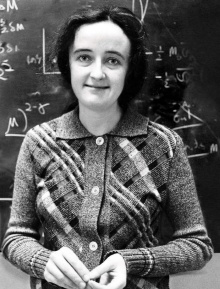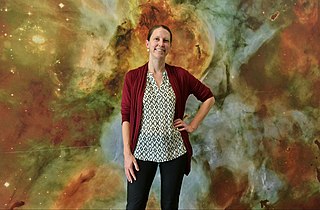
The American Astronomical Society is an American society of professional astronomers and other interested individuals, headquartered in Washington, DC. The primary objective of the AAS is to promote the advancement of astronomy and closely related branches of science, while the secondary purpose includes enhancing astronomy education and providing a political voice for its members through lobbying and grassroots activities. Its current mission is to enhance and share humanity's scientific understanding of the universe as a diverse and inclusive astronomical community.

Annie Jump Cannon was an American astronomer whose cataloging work was instrumental in the development of contemporary stellar classification. With Edward C. Pickering, she is credited with the creation of the Harvard Classification Scheme, which was the first serious attempt to organize and classify stars based on their temperatures and spectral types. She was nearly deaf throughout her career after 1893, as a result of scarlet fever. She was a suffragist and a member of the National Women's Party.

Vera Florence Cooper Rubin was an American astronomer who pioneered work on galaxy rotation rates. She uncovered the discrepancy between the predicted and observed angular motion of galaxies by studying galactic rotation curves. These results were later confirmed over subsequent decades. Her work on the galaxy rotation problem was cited by others as evidence for the existence of dark matter. The Vera C. Rubin Observatory in Chile is named in her honor.

Beatrice Muriel Hill Tinsley was a British-born New Zealand astronomer and cosmologist, and the first female professor of astronomy at Yale University, whose research made fundamental contributions to the astronomical understanding of how galaxies evolve, grow and die.
Jeremiah Paul "Jerry" Ostriker is an American astrophysicist and a professor of astronomy at Columbia University and is the Charles A. Young Professor Emeritus at Princeton, where he also continues as a senior research scholar. Ostriker has also served as a university administrator as Provost of Princeton University.
Annette Mairi Nelson Ferguson FRSE is a Scottish observational astrophysicist who specialises in the area of galaxy evolution. She is a professor at the Institute for Astronomy, Edinburgh, and holds the Personal Chair in Observational Astrophysics at the School of Physics and Astronomy, University of Edinburgh.
Amy J. Barger is an American astronomer and Henrietta Leavitt Professor of Astronomy at the University of Wisconsin–Madison. She is considered a pioneer in combining data from multiple telescopes to monitor multiple wavelengths and in discovering distant galaxies and supermassive black holes, which are outside of the visible spectrum. Barger is an active member of the International Astronomical Union.
Dr. Sally Oey is an American astronomer at the University of Michigan and an expert in massive, hot stars which are often precursors to supernovae. In 1999, she was awarded the Annie J. Cannon Award in Astronomy by the American Astronomical Society (AAS) and, in 2006, was invited to give an address to the 206th meeting of the AAS. Oey is currently a professor and is a member of the board of the Gemini Observatory. In 2023, the University of Michigan named her an Arthur F. Thurnau Professor in recognition of her contributions to undergraduate education.

The Harvard Computers were a team of women working as skilled workers to process astronomical data at the Harvard College Observatory in Cambridge, Massachusetts, United States. The team was directed by Edward Charles Pickering and, following his death in 1919, by Annie Jump Cannon.
The women were challenged to make sense of these patterns by devising a scheme for sorting the stars into categories. Annie Jump Cannon's success at this activity made her famous in her own lifetime, and she produced a stellar classification system that is still in use today. Antonia Maury discerned in the spectra a way to assess the relative sizes of stars, and Henrietta Leavitt showed how the cyclic changes of certain variable stars could serve as distance markers in space.
Rosemary F. G. Wyse is a Scottish astrophysicist, Fellow of the Royal Astronomical Society (FRAS), and Alumni Centennial Professor of Physics and Astronomy at Johns Hopkins University.

Claudia Megan Urry is an American astrophysicist, who has served as the President of the American Astronomical Society, as chair of the Department of Physics at Yale University, and as part of the Hubble Space Telescope faculty. She is currently the Israel Munson Professor of Physics and Astronomy at Yale University and Director of the Yale Center for Astronomy and Astrophysics. Urry is notable not only for her contributions to astronomy and astrophysics, including work on black holes and multiwavelength surveys, but also for her work addressing sexism and sex equality in astronomy, science, and academia more generally.

Laura Ferrarese is a researcher in space science at the National Research Council of Canada. Her primary work has been performed using data from the Hubble Space Telescope and the Canada-France-Hawaii Telescope.

Heather A. Knutson is an astrophysicist and professor of planetary science at California Institute of Technology in the Division of Geological and Planetary Sciences. Her research is focused on the study of exoplanets, their composition and formation.

Smadar Naoz is an Israeli-American astrophysicist, and was the 2015 winner of the Annie Jump Cannon Award in Astronomy for her scientific contributions to the fields of cosmology and planetary dynamics.
Ann Hornschemeier is an American astronomer specializing in X-ray emission from X-ray binary populations. She is the Chief Scientist for the Physics of the Cosmos program at NASA.

Vassiliki Kalogera is a Greek astrophysicist. She is a professor at Northwestern University and the director of the Center for Interdisciplinary Exploration and Research in Astrophysics (CIERA). She is a leading member of the LIGO Collaboration that observed gravitational waves in 2015.
Harriet Dinerstein is an American astronomer. The American Astronomical Society honored her work by awarding her the Annie J. Cannon Prize in 1985. She also received the Newton Lacy Pierce Prize in 1989. Dinerstein received her Bachelor of Science degree from Yale University in 1975 and her Ph.D. from the University of California, Santa Cruz in 1980. She currently is a Professor of Astronomy at the University of Texas at Austin.
Christine D. Wilson is a Canadian-American physicist and astronomer, currently a University Distinguished Professor at McMaster University.
Blakesley Burkhart is an astrophysicist. She is the winner of the 2017 Robert J. Trumpler Award awarded by the Astronomical Society of the Pacific, which recognizes a Ph.D. thesis that is "particularly significant to astronomy." She also is the winner of the 2019 Annie Jump Cannon Award in Astronomy and the 2022 winner of The American Physical Society's Maria Goeppert-Mayer Award. The awards both cited her work on magnetohydrodynamic turbulence, and for developing innovative techniques for comparing observable astronomical phenomena with theoretical models.
Barbara Sue Ryden is an American astrophysicist who is a Professor of Astronomy at Ohio State University. Her research considers the formation, shape and structure of galaxies. She was elected a fellow of the American Association for the Advancement of Science in 2016.









